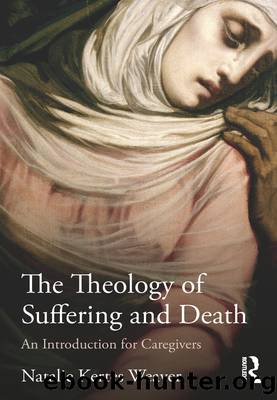The Theology of Suffering and Death by Weaver Natalie Kertes;

Author:Weaver, Natalie Kertes;
Language: eng
Format: epub
ISBN: 1092638
Publisher: Taylor & Francis Group
Violence and war
In his work A Century of War: The History of Worldwide Conflict in the 20th Century,6 David Miller evaluates eight major international conflicts, twenty-five regional conflicts and major civil wars, and eleven insurgencies and insurrections. Accompanied by photographic detail, Miller explores the history of twentieth-century conflicts, the cost to national treasuries, and the incomprehensible death toll (as far as it is known) of these wars and battles. Despite the scope of the book, Miller chillingly observes that conflict in the past century was so far flung and pervasive that his own work can only survey some of the conflicts people endured. He claims, âit is doubtful if there has been one day in the century when there has not been at least one conflict somewhere in the world, and frequently more.â7
The extent of war in the past century and into the first decades of the present one is vast. The First (1914â18) and Second (1939â45) World Wars occurred on an unprecedented, global scale. The combined, estimated military dead of the First World War is over nine million people, with nineteen million more wounded.8 In the Second World War, over thirteen million (combined Axis and Allied) military died, and over twenty-five million more were wounded.9 An estimated six million Jews were murdered in the Holocaust, alongside five million more non-Jewish citizens. Hundreds of thousands died and were wounded when the United States dropped atom bombs on Hiroshima and Nagasaki, Japan. Moreover, in the dozens of regional and civil wars that raged, millions more lives have been lost, destroyed, and grieved.
The staggering numbers of military lives lost in the past century to warfare is gravely compounded by the astounding reality of genocides by the murderous dictators behind these conflicts. The extent of the suffering and loss of civilian lives is almost impossible to grasp meaningfully. For example, in Piero Scaruffiâs survey of twentieth-century genocides, he credits Mao Ze-Dong with somewhere between fifty and seventy-eight million Chinese dead.10 In another example, Terry Staffordâs research into the Soviet Gulag suggests that over sixty-one million people were killed under Joseph Stalinâs extermination policies. Stafford drives home the point in his description of the transportation process to the Gulag during this reign of terror. Prisoners on ships were often frozen in the ice, later to be fed to the living or tossed aside to decompose eventually in the summer thaw. He goes on:11
Other accounts tell us that while the secret police administered the operation of the camps, inside the barracks criminal leaders ruled, abusing the weak. Women in the Gulag were almost always considered prey. They were often raped on transport ships or in railroad cars, even before they reached the camps. Upon arrival at their destination they would be paraded naked in front of camp officials, who would select their favorites to provide sexual favors to their new masters. Women not selected became âprizesâ for male (and sometimes female) inmates. The pitiful creatures inhabiting the world of the Gulag suffered from starvation, exhaustion, exposure, and physical abuse on a routine basis.
Download
This site does not store any files on its server. We only index and link to content provided by other sites. Please contact the content providers to delete copyright contents if any and email us, we'll remove relevant links or contents immediately.
Fangirl by Rainbow Rowell(8808)
How to Bang a Billionaire by Alexis Hall(7942)
Wonder by R. J. Palacio(7750)
The Space Between by Michelle L. Teichman(6589)
The Thirst by Nesbo Jo(6458)
Assassin’s Fate by Robin Hobb(5867)
Wiseguy by Nicholas Pileggi(5336)
The Night Circus by Erin Morgenstern(5044)
The Kite Runner by Khaled Hosseini(4963)
Paper Towns by Green John(4815)
Bittersweet (True North #1) by Sarina Bowen(4720)
Gerald's Game by Stephen King(4386)
Too Much and Not the Mood by Durga Chew-Bose(4105)
Pillow Thoughts by Courtney Peppernell(4039)
Goodbye Paradise(3464)
Twelve Days of Christmas by Debbie Macomber(3421)
Good by S. Walden(3361)
The Rosie Effect by Graeme Simsion(3223)
The Cellar by Natasha Preston(3081)
